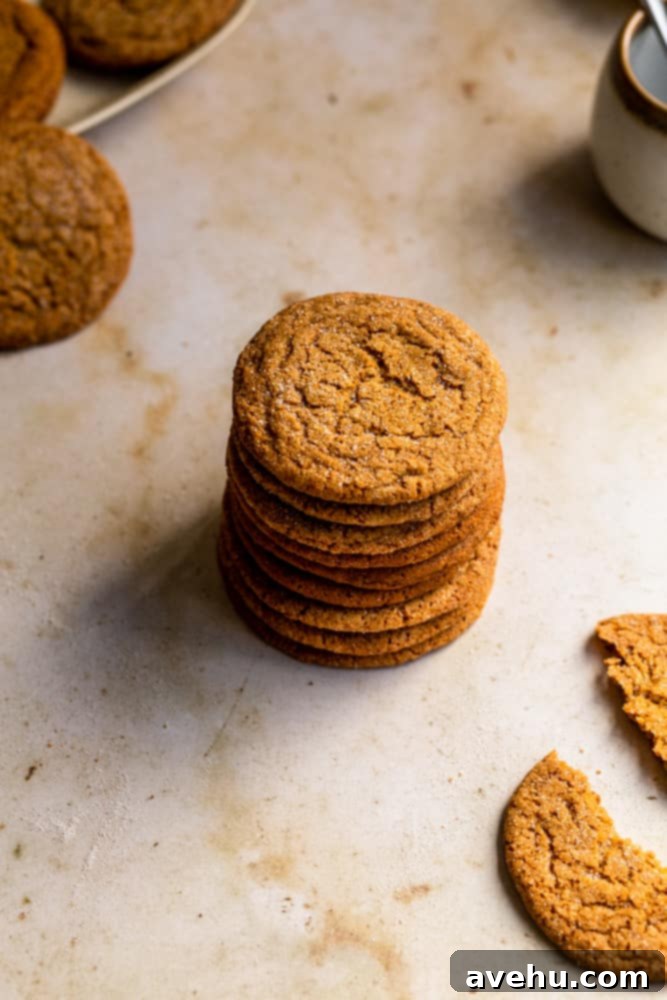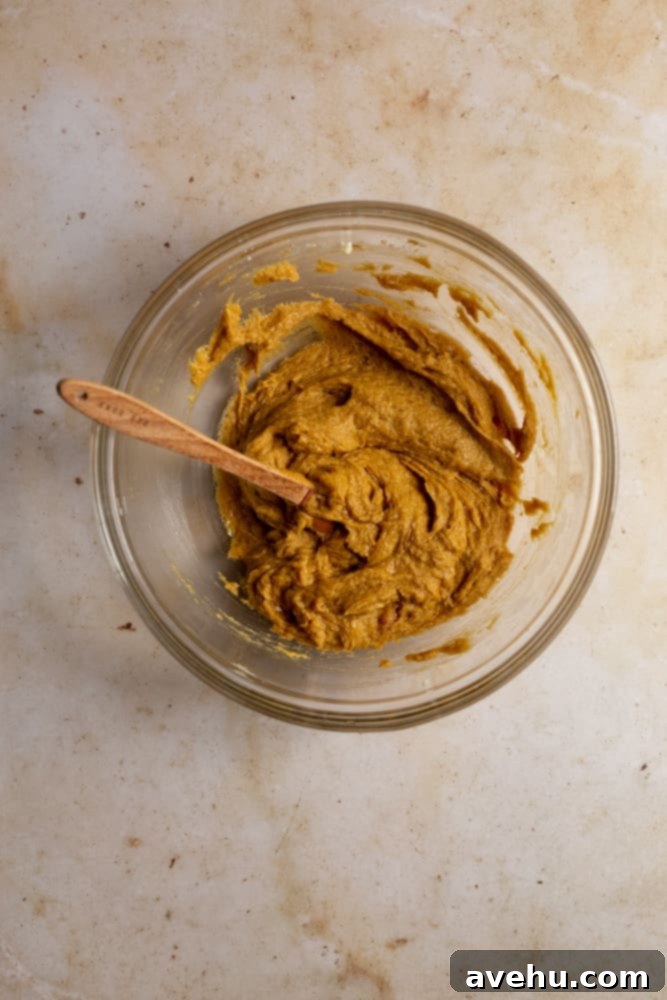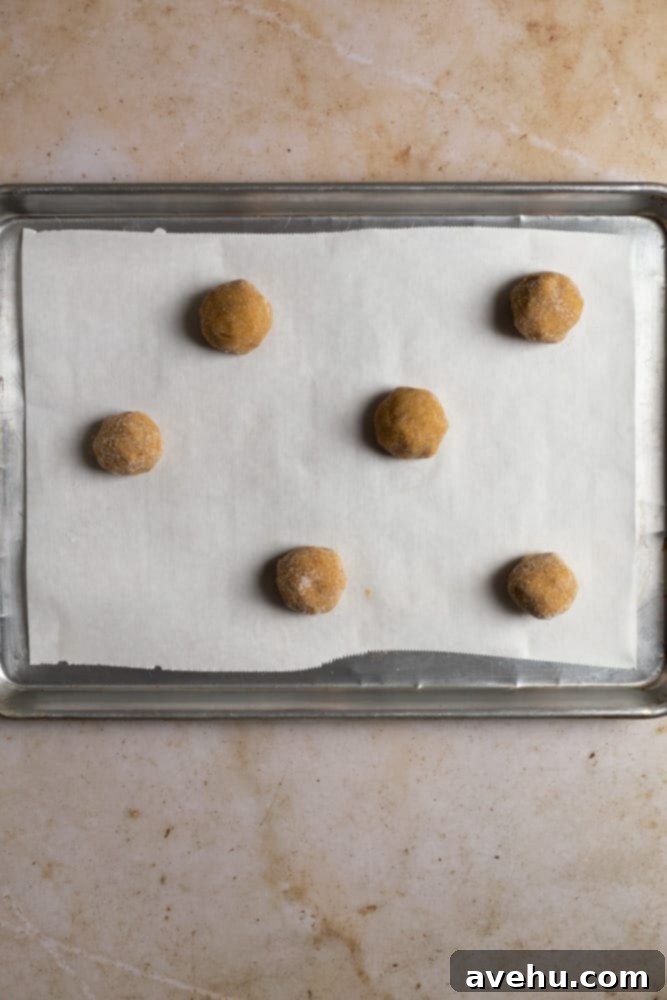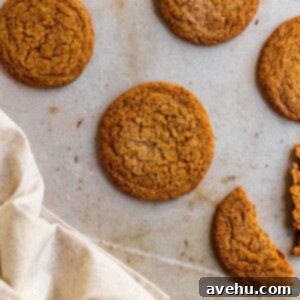The Best No-Chill Crispy Gingersnap Cookies: Your Quick and Easy Holiday Favorite
Prepare to discover your new favorite holiday cookie: these unbelievably thin and crispy gingersnap cookies! Crafted to deliver that quintessential “snap” with every bite, this recipe stands out because it requires absolutely no chilling time for the dough. That means you can go from craving to warm, freshly baked cookies in just about 25 minutes. Perfect for busy holiday seasons or spontaneous baking urges, these easy gingersnap cookies are guaranteed to become a cherished part of your festive traditions. Their delightful spice blend and satisfying texture make them an irresistible treat that everyone will adore, making them an essential addition to any holiday cookie platter or a simple, comforting snack on a cold evening.

Having spent years honing my craft as a trained pastry chef, I’ve had the pleasure of baking countless cookie recipes. From intricate designs to classic comforts, each has its charm. However, among all the confections, these particular crispy gingersnap cookies hold a special place in my heart. They embody everything I love about holiday baking: warmth, spice, and a touch of magic. It’s truly a recipe that delivers on all fronts, consistently producing perfect results that are sure to impress both family and friends.
What truly elevates this recipe for me is the harmonious blend of flavors, the impeccable crispy texture that gives them their signature “snap,” and, perhaps most importantly, the incredible convenience of a no-chill dough. This innovative approach means you can enjoy these exquisite, spiced cookies in under 30 minutes – a game-changer for last-minute gatherings or when a sweet craving strikes without warning during the busy holiday season.
Often, cookie recipes necessitate chilling the dough to prevent excessive spreading in the oven, ensuring your cookies maintain a desirable shape and thickness. This critical step, while effective, adds significant time to the baking process. However, a unique balance of ingredients and precise ratios in this gingersnap recipe allows the cookies to hold their shape beautifully and bake into perfectly round, thin discs without any prior refrigeration. This ingenious method means you can bypass the waiting game and get straight to baking, making these gingersnaps not only delicious but also remarkably efficient and ideal for those moments when time is of the essence.
Distinguished by their delicate texture, these aren’t the chewy gingersnaps you might encounter elsewhere; instead, they are wonderfully thin and crispy, delivering that satisfying crunch with every bite. The exquisite flavor profile is built upon a classic combination of warm, aromatic ground spices: robust ginger, comforting cinnamon, and a hint of fragrant nutmeg. This blend is carefully measured to provide just the right amount of festive spice, creating a harmonious and inviting taste that sings of the holidays. Complementing these spices, dark molasses plays a crucial role, imparting a deep, rich, and slightly smoky sweetness that is the hallmark of truly exceptional gingersnap cookies. It’s this combination that creates an unparalleled depth of flavor and an unforgettable experience.
Beyond these sensational crispy gingersnap cookies, the holiday season always inspires me to create other festive delights that I typically reserve for this special time of year. Among my favorites are these wonderfully crunchy gingerbread biscotti, which are perfect for dipping into hot coffee or tea, and this incredibly moist and effortlessly delicious gingerbread bundt cake. The aroma of these seasonal treats baking fills the entire home with holiday cheer, creating lasting memories.
Indeed, the holidays offer a unique opportunity to indulge in comforting flavors and cherished traditions. When it comes to other essential holiday cookies, our family absolutely adores these soft and chewy vanilla sugar cookies, which are fantastic for decorating with festive icing and sprinkles. We also love the intensely rich and fudgy chocolate brownie cookies, offering a decadent chocolate fix. And, of course, these delightful Rum balls – while they might not technically be classified as cookies, their simple preparation and rich, boozy flavor make them an indispensable addition to any holiday dessert platter or gifting assortment.
Essential Ingredients for Perfect Gingersnaps

Crafting the perfect gingersnap cookie relies on a few key ingredients, each playing a vital role in achieving that distinct flavor and crispy texture. Understanding these components will ensure your baking success and help you create the best gingersnaps every time.
Molasses: The Heart of the Flavor
Central to the signature taste of a classic gingersnap cookie is molasses. Its deep, complex, and slightly bitter-sweet profile is irreplaceable, providing that unique warmth and richness. When selecting molasses, it is absolutely crucial to choose unsulfured molasses. This type is lighter in flavor and color compared to its stronger counterparts, making it ideal for baking and achieving the delicate balance of sweetness and spice in these cookies. I personally recommend the Grandma’s brand, often found in a yellow jar, for its consistent quality and perfect consistency. While this molasses is dark, it is distinctly different from blackstrap molasses. Please note, you cannot substitute blackstrap molasses or any other syrup for unsulfured molasses in this recipe, as it will drastically alter the flavor and texture of your cookies, leading to a potentially bitter and undesirable outcome.
This particular recipe does not call for cloves, allowing the vibrant ginger and other warm spices to shine unimpeded. However, if you are a fan of cloves and enjoy their intense, aromatic contribution, feel free to add a pinch (1/4 to 1/2 teaspoon) to the dry ingredients for an extra layer of complexity. My personal preference is to highlight all the warm spices present here, opting to omit cloves for a slightly brighter, less intense spice profile that truly lets the ginger take center stage.
Spices: The Aromatic Foundation
Beyond the essential ginger, this recipe uses a harmonious blend of ground cinnamon and nutmeg. Cinnamon adds a sweet, woody warmth that complements the ginger beautifully, while nutmeg contributes a subtle, sweet, and slightly peppery note, rounding out the spice blend. Together with ground ginger, these spices create the comforting and irresistible aroma and flavor that define perfect gingersnap cookies, making them truly taste like the holidays. Ensure your spices are fresh, as older spices lose their potency and won’t deliver the vibrant flavor required for these cookies.
Flour, Sugar, Butter & Egg: The Structural Elements
All-purpose flour provides the necessary structure to these thin cookies, giving them their crispy foundation. Granulated sugar not only contributes sweetness but also aids in achieving that desirable crispiness and helps with the crackled tops. Softened unsalted butter adds richness, essential moisture, and helps create that desirable tender crumb while enhancing the overall flavor. Finally, a large egg binds all the ingredients together, adds moisture, and enriches the dough, contributing to the cookie’s overall texture. Always ensure your butter is at room temperature for proper creaming with the sugar, which is essential for incorporating air and creating the ideal cookie texture.
Understanding Molasses: Unsulfured vs. Blackstrap
The world of molasses can be a bit confusing due to its various types, but distinguishing between unsulfured and blackstrap varieties is a critical piece of knowledge for any home baker, especially when making gingersnaps. Choosing the correct type will profoundly impact the flavor and texture of your finished product.
Unsulfured molasses is what is generally considered “regular” molasses that you find readily available in most grocery stores. It is produced from mature sugarcane that has been allowed to ripen naturally, meaning it doesn’t require the addition of sulfur dioxide as a preservative (hence “unsulfured”). This type of molasses undergoes a process where the sugarcane juice is boiled, and sugar crystals are extracted. The resulting syrup is lighter in color and possesses a sweeter, milder, and more balanced flavor profile. This makes it incredibly versatile and perfect for most baking applications, including our gingersnap cookies, where its nuanced sweetness complements the spices without overpowering them. As previously mentioned, I highly recommend Grandma’s brand, which is a reliable choice and easily identifiable by its distinct yellow packaging.
In stark contrast, blackstrap molasses is a byproduct of the third and final boiling of sugarcane syrup, after the maximum possible amount of sugar has been extracted. This rigorous processing results in a very dark, incredibly thick, and highly concentrated liquid with a distinctly robust, intensely bitter, and somewhat mineral-like flavor. While blackstrap molasses is revered for its high nutritional content – packed with iron, calcium, and potassium – and is often used in health supplements or certain savory dishes (like baked beans), its profound bitterness is far too overpowering and completely unsuitable for this gingersnap cookie recipe. Using blackstrap molasses would, unfortunately, result in cookies with an unpleasantly sharp, acrid, and medicinal taste, completely detracting from the desired warm, sweet, and spicy profile. Therefore, please exercise caution and ensure you pick up unsulfured molasses for these delicate treats.
Baking Delight: Step-by-Step Crispy Gingersnap Cookies
Making these crispy gingersnap cookies is a straightforward process, designed for maximum flavor with minimal fuss and no waiting time. Follow these simple steps precisely to achieve perfect, beautifully crackled tops and that irresistible, satisfying snap every time.
- Prepare Your Workspace and Preheat Oven: Begin by preheating your oven to 350°F (175°C) to ensure it reaches the correct temperature before the dough is ready. While the oven heats up, meticulously line two standard baking sheets with high-quality parchment paper. This non-stick surface is crucial for preventing the cookies from sticking, ensuring even baking, and allowing for effortless removal without breakage.
- Cream Butter and Sugar: In the generously sized bowl of a stand mixer equipped with the paddle attachment, combine the well-softened unsalted butter and precisely 1 cup of granulated sugar. Beat these ingredients together on medium speed until they transform into a light, fluffy, and creamy paste. This initial creaming process is vital as it incorporates air into the mixture, which is essential for contributing to the cookie’s tender yet crispy texture. If you don’t have a stand mixer, a large mixing bowl and a sturdy spatula or a reliable hand mixer will work just as effectively. Continue mixing until the mixture is visibly pale and airy, typically for about 1 to 2 minutes.
- Incorporate Wet Ingredients: Once the butter and sugar are perfectly creamed, reduce the mixer speed to low. Carefully add the unsulfured molasses and the large egg to the creamed butter and sugar mixture. Continue mixing gently until all the liquid ingredients are thoroughly combined and a smooth, loose batter has formed. Be diligent in scraping down the sides of the bowl with a rubber spatula to ensure that everything is incorporated evenly and no dry pockets remain.
- Add Dry Ingredients: In a separate medium-sized bowl, whisk together the all-purpose flour, baking soda, ground cinnamon, ground nutmeg, ground ginger, and kosher salt. Whisking dry ingredients together before adding them to the wet mixture ensures that the spices and leavening agents are perfectly and evenly distributed throughout the dough. Gradually add these combined dry ingredients to the wet mixture, mixing on low speed until just combined. It’s crucial to avoid overmixing at this stage, as it can overdevelop the gluten in the flour, leading to tough, undesirable cookies. Stop mixing as soon as no streaks of flour remain visible and a firm, cohesive dough has formed.
- Scoop and Sugar Coat the Dough: Pour the remaining ½ cup of granulated sugar into a small, shallow bowl; this will be your coating station. Using a 2-tablespoon cookie scoop (or roughly 1-inch diameter if you prefer rolling by hand), portion out the cookie dough. Roll each scoop of dough into a neat, uniform ball between your palms to ensure even baking. Then, gently roll each dough ball in the bowl of sugar, ensuring it’s completely coated. This generous sugar coating not only adds a beautiful sparkle but also plays a crucial role in creating the signature crispy edge and the desired crinkled top.
- Bake to Perfection: Arrange 6 sugar-coated cookie dough balls onto each prepared baking sheet, ensuring you leave ample space (at least 2 inches) between them to allow for slight spreading during baking. The best part? There’s absolutely no need to chill the dough for this recipe, meaning instant gratification! Place the baking sheets in the preheated oven and bake for approximately 15 minutes. The cookies are perfectly done when their edges are set and delightfully crispy, and their tops have developed those characteristic beautiful crinkles and cracks.
- Cool and Enjoy: Once baked, promptly remove the cookies from the oven and allow them to rest and cool on the baking sheets for a few minutes. This brief resting period allows them to firm up slightly. Then, carefully transfer the warm gingersnaps to a wire rack to cool completely. Cooling on a rack facilitates optimal air circulation around the cookies, which is key to helping them achieve their ultimate crispiness and firm texture. Once fully cooled, they’re ready to be enjoyed with a cup of coffee, tea, or a cold glass of milk!




Expert Tips for Your Best Crispy Gingersnaps
Achieving bakery-quality gingersnap cookies is easy with a few simple tips that can elevate your baking from good to absolutely phenomenal:
- Accurate Flour Measurement is Key: Precise ingredient measurement is fundamental in baking, especially for flour, as it significantly impacts the final texture of your cookies. The most accurate method is to use a digital kitchen scale to weigh your flour (281.25g for 2 1/4 cups). If you’re relying on measuring cups, avoid the common mistake of scooping directly from the flour bag, as this compacts the flour and inevitably results in too much being added. Instead, gently spoon the flour into your measuring cup until it’s overflowing, then carefully level it off with the back of a knife or a straight edge. Over-measured flour can lead to dense, dry, and crumbly cookies, detracting significantly from that desired crispy texture and delightful snap.
- Adjust for Larger Cookies: If you prefer a more substantial, satisfying cookie, you can certainly scale up the size. Use a regular-sized ice cream scoop (approximately 3-4 tablespoons) to portion out the dough. For these larger cookies, you’ll need to increase the baking time slightly to 16-18 minutes, or until the edges are beautifully golden brown and the tops are wonderfully cracked. Always keep a close eye on them during the extended baking time, as oven temperatures can vary.
- Elevate the Crunch with Specialty Sugars: For an even more delightful crunch and a visibly sparkling, festive appearance, consider rolling your cookie dough balls in sanding sugar or turbinado (coarse) sugar instead of just regular granulated sugar. These larger, coarser sugar crystals hold up better during the baking process, creating a fantastic textural contrast and an extra layer of sweetness that enhances the overall eating experience.
- Creative Uses for Leftover Gingersnaps: Should you find yourself with any extra crispy gingersnap cookies (a rare and delightful problem, I assure you!), they are incredibly versatile and can be repurposed in numerous delicious ways. They make an exceptional, flavorful base for cheesecakes, pie crusts, or tarts where graham crackers are traditionally used. Simply crush them into fine crumbs and proceed with your recipe – the inherent ginger and molasses notes add a wonderful, complex depth of flavor to any dessert. You can also crumble them over vanilla ice cream, plain yogurt, or use them as a spiced topping for fruit crisps or crumbles.
- Don’t Crowd the Baking Sheets: It’s crucial to always ensure you leave adequate space (at least 2 inches) between each cookie dough ball on the baking sheet. This generous spacing allows for proper air circulation around each cookie as it bakes, which is essential for uniform baking and crispiness. Crowding the baking sheets can lead to unevenly baked cookies that steam rather than crisp, potentially spreading into each other and preventing them from achieving that beautiful, individual shape and signature snap.
Achieving the Signature Crackled Tops
One of the most appealing characteristics of classic gingersnap cookies, besides their incredible flavor and satisfying snap, is their beautifully crinkled, crackled tops. These distinctive visual cues are not just for aesthetics; they indicate a perfectly baked cookie that has achieved its ideal texture. If your gingersnap cookies aren’t developing those charming cracks, there are typically two main culprits to investigate, both of which are easily remedied:
1. Precise Baking Soda Measurement: The Chemical Magic
The magic behind those iconic crackled tops lies in a fascinating chemical reaction involving the baking soda. Baking soda (sodium bicarbonate) is an alkaline ingredient. When it’s combined with the acidic components naturally present in molasses (and brown sugar, if used in a chewy variation), it produces carbon dioxide gas. As the cookies bake in the hot oven, this gas rapidly expands, causing the dough to rise quickly. As the cookie structure sets, the gas eventually escapes, and the surface of the dough then collapses slightly, creating those distinct, irregular cracks and crinkles on the top. Therefore, it is absolutely essential to measure your baking soda accurately. Using too little will result in fewer cracks, a flatter appearance, and a denser cookie texture, as there isn’t enough gas production. Conversely, using too much baking soda can lead to a somewhat soapy or metallic taste, which is undesirable. Always ensure you’re using a level teaspoon for the precise amount specified in the recipe to guarantee the perfect chemical reaction and the most beautiful crackled tops.
2. Adequate Baking Time: Patience for Crispiness and Cracks
Patience truly is a virtue in baking, especially when your goal is to achieve maximum crispiness and those beautiful cracks. Resist the temptation to pull the cookies from the oven too soon, even if they look mostly done. They require the full 15 minutes (or slightly longer for larger cookies, typically 16-18 minutes) to properly bake through. This extended baking time allows sufficient moisture to evaporate from the dough, causing the edges to crisp up and the cookie to become firm. Furthermore, this duration gives the leavening agents enough time to perform their work fully, contributing significantly to the development of those desired crinkles and the overall structural integrity of the cookie. Cookies that are underbaked will remain soft, pliable, and won’t achieve that satisfying “snap” or the beautiful surface cracks that are so characteristic of a classic gingersnap. Look for clear indications of doneness: golden-brown edges, a firm center when gently pressed, and prominent cracks across the top surface.
Craving Chewy? Adapting Your Gingersnaps
While this recipe is specifically designed and perfected to produce wonderfully thin and crispy gingersnap cookies with an irresistible snap, I understand that many bakers and cookie enthusiasts might occasionally prefer a softer, chewier texture. If you’re looking to modify these into a delightful chewy ginger cookie, there’s a simple yet effective adjustment you can make to alter their consistency without compromising their rich, spicy flavor:
To achieve a chewier consistency, you can easily substitute half of the granulated white sugar with an equal amount of light or dark brown sugar. For example, if the original recipe calls for 1 cup of granulated sugar, you would adjust this to use ½ cup of granulated sugar and ½ cup of packed brown sugar instead. The magic behind this textural transformation lies in the brown sugar itself; unlike white sugar, brown sugar contains a significant amount of molasses, which is naturally hygroscopic (meaning it attracts and retains moisture). This increased moisture content introduced by the brown sugar helps keep the cookies softer and more pliable after baking, resulting in that wonderfully chewy texture characteristic of a classic molasses cookie. The additional molasses in brown sugar also adds another layer of deep, caramel-like flavor.
However, it’s important to set your expectations accordingly and understand the trade-off: while the flavor will remain rich, spicy, and deeply satisfying, opting for a chewy variation will inherently diminish or even completely eliminate the signature “snap” that defines these crispy gingersnap cookies. The delicate balance of ingredients that creates the unique crispness is fundamentally altered when more moisture is introduced into the dough. So, embrace the delicious chewiness and the enhanced molasses flavor, but be aware that the characteristic satisfying crackle and crunch might be traded for a softer, more yielding bite. Both versions are incredibly delicious, but they offer distinct textural experiences.



25 Minute Thin and Crispy Gingersnap Cookies
Ingredients
- 1 cup (227 g) unsalted butter, softened to room temperature
- 1 cup (200 g) granulated sugar, plus an additional 1/2 cup for rolling cookies
- 1/4 cup (84.25 g) molasses, unsulfered (do not use blackstrap)
- 1 (1) large egg, at room temperature
- 2 1/4 cup (281.25 g) all purpose flour
- 1 1/2 tsp (1.5 tsp) baking soda
- 1/2 tsp (0.5 tsp) ground cinnamon
- 1/2 tsp (0.5 tsp) ground nutmeg
- 1/2 tsp (0.5 tsp) ground ginger
- 1/4 tsp (0.25 tsp) kosher salt
Instructions
- Preheat your oven to 350°F (175°C) and meticulously line two large baking sheets with parchment paper; this ensures easy release and prevents sticking.
- In a medium sized bowl or in the bowl of a stand mixer, combine the 1 cup softened butter with the 1 cup granulated sugar and mix on medium speed until a light, creamy paste forms, about 1-2 minutes. Use a sturdy spatula if you’re making this by hand or the paddle attachment if using a mixer.
- With the mixer on low speed, add in the 1/4 cup unsulfured molasses and one large egg. Continue mixing until a smooth, loose batter forms, about 30 seconds, scraping down the bowl as needed.
- In a separate small bowl, combine the 2 1/4 cups all-purpose flour with the 1 1/2 tsp baking soda and 1/2 tsp each of ground cinnamon, nutmeg, and ginger along with 1/4 tsp kosher salt. Gradually add these dry ingredients to the wet mixture and mix on medium speed until a firm, cohesive batter forms, typically 1-2 minutes. Avoid overmixing.
- Pour the remaining 1/2 cup granulated sugar into a small, shallow bowl for coating. Scoop out the cookie dough using a small ice cream scoop or a large kitchen spoon. Roll each portion of dough into 1-inch cookie dough balls, then generously roll them in the sugar to coat completely.
- Stagger 6 sugar-coated cookies at a time on each prepared baking sheet, leaving ample space between them. Bake for 15 minutes until their edges are set and the tops are beautifully crinkled. No need to chill!
